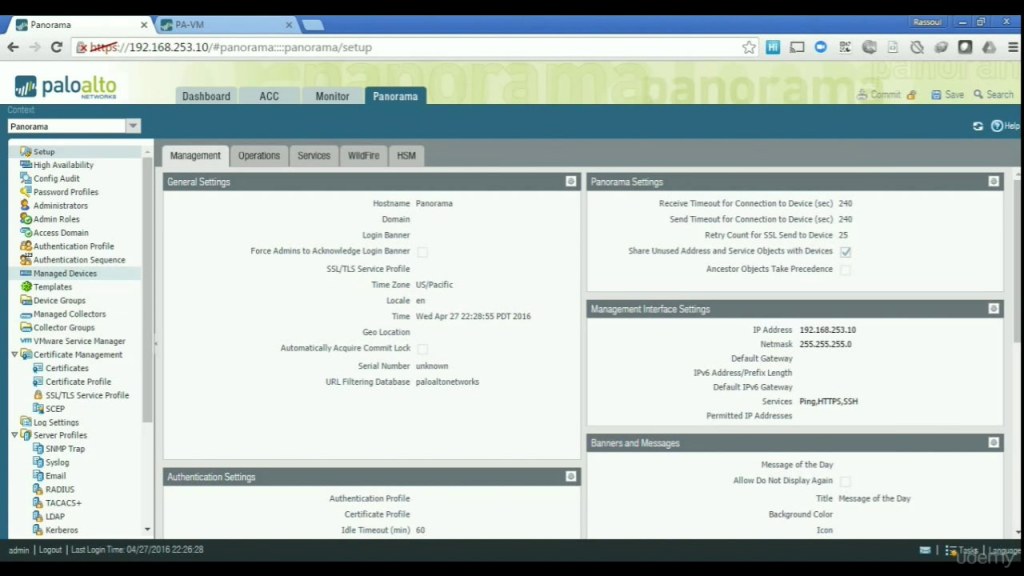Supercharge Your Network Security: Learn How To Add Palo Alto Firewall To Panorama Today!
How to Add Palo Alto Firewall to Panorama
Greetings, Happy People! Today, we will be discussing an important topic in the field of network security: how to add a Palo Alto Firewall to Panorama. In this article, we will provide you with a step-by-step guide on how to seamlessly integrate these two powerful tools to enhance your network’s security and management capabilities. So, let’s dive in!
Introduction
Network security is a critical aspect of any organization’s IT infrastructure. With the ever-increasing number of cyber threats, it is vital to have robust security measures in place to safeguard sensitive data and protect against unauthorized access. Palo Alto Firewall and Panorama, both renowned solutions in the cybersecurity realm, offer comprehensive security features and centralized management, respectively. Integrating these two tools allows for streamlined security management and enhanced visibility across the network.
2 Picture Gallery: Supercharge Your Network Security: Learn How To Add Palo Alto Firewall To Panorama Today!
In this article, we will walk you through the process of adding a Palo Alto Firewall to Panorama, starting from the initial setup to the final configuration. By following our guide, you will be able to efficiently deploy and manage your Palo Alto Firewall within the Panorama management platform.
Before we proceed, let’s take a closer look at each of these tools and understand their functionalities.
What is Palo Alto Firewall?
Image Source: paloaltonetworks.com
Palo Alto Firewall is a next-generation firewall that provides advanced threat prevention and network security capabilities. It offers a wide range of features, including intrusion prevention, URL filtering, antivirus protection, and application control. Palo Alto Firewall is widely recognized for its superior performance and ability to identify and mitigate threats in real-time.
What is Panorama?
Panorama is a centralized management platform offered by Palo Alto Networks. It allows network administrators to efficiently manage multiple firewalls from a single interface. Panorama provides comprehensive visibility, policy management, and reporting capabilities, making it easier to monitor and control network security across multiple locations.
Who Should Use Palo Alto Firewall and Panorama?
Palo Alto Firewall and Panorama are suitable for organizations of all sizes and industries. Whether you are a small business owner or a large enterprise, these tools can significantly enhance your network security posture. Network administrators, IT managers, and cybersecurity professionals can benefit from the advanced security features and centralized management functionalities offered by Palo Alto Firewall and Panorama.
When Should You Consider Adding Palo Alto Firewall to Panorama?
Adding Palo Alto Firewall to Panorama becomes essential when you have multiple firewalls deployed within your network infrastructure. The integration allows you to centralize the management of these firewalls, simplifying administration and ensuring consistent security policies across all devices. If you are experiencing challenges in managing your existing firewalls or require a more holistic approach to network security, adding Palo Alto Firewall to Panorama is a wise decision.
Where Can You Add Palo Alto Firewall to Panorama?

Image Source: ytimg.com
Palo Alto Firewall can be added to Panorama both in on-premises and cloud environments. Whether you have a physical data center or leverage cloud infrastructure, the integration process remains the same. Both Palo Alto Firewall and Panorama support a wide range of deployment options, providing flexibility and scalability to meet your organization’s specific requirements.
Why Should You Add Palo Alto Firewall to Panorama?
There are several compelling reasons to add Palo Alto Firewall to Panorama:
1. Centralized Management: By integrating Palo Alto Firewall with Panorama, you can centrally manage multiple firewalls from a single interface, simplifying administration and reducing management overhead.

Image Source: ytimg.com
2. Enhanced Visibility: Panorama provides comprehensive visibility into network traffic and security events, allowing you to quickly identify and respond to potential threats.
3. Consistent Security Policies: With Palo Alto Firewall and Panorama integration, you can enforce consistent security policies across your network, ensuring uniform protection against cyber threats.
4. Streamlined Workflow: The seamless integration between Palo Alto Firewall and Panorama streamlines security operations, enabling faster response times and efficient management.
5. Scalability: Palo Alto Firewall and Panorama are designed to scale as your network grows. Adding new firewalls to Panorama is a straightforward process, ensuring scalability without compromising security.
How to Add Palo Alto Firewall to Panorama?
Now that we have covered the basics, let’s dive into the detailed steps of adding Palo Alto Firewall to Panorama:
Step 1: Prepare the Environment
The first step is to ensure that your network environment meets the prerequisites for integrating Palo Alto Firewall with Panorama. This includes verifying hardware compatibility, network connectivity, and software versions. Refer to the documentation provided by Palo Alto Networks for the specific requirements.
Step 2: Configure Palo Alto Firewall
Next, configure your Palo Alto Firewall by assigning IP addresses, configuring interfaces, and setting up security policies. Ensure that the firewall is properly connected to your network and can access the internet to download necessary software updates.
Step 3: Set Up Panorama
After configuring the firewall, proceed to set up Panorama. Install Panorama on a dedicated server or virtual machine, following the provided installation guide. Ensure that Panorama is reachable from the Palo Alto Firewall and has the necessary network connectivity.
Step 4: Add Firewall to Panorama
Once both Palo Alto Firewall and Panorama are ready, you can add the firewall to Panorama. This involves creating a device group and a template within Panorama and associating the firewall with the appropriate group and template. Follow the step-by-step instructions provided in the Panorama documentation to complete this process.
Step 5: Configure Policies and Objects
With the firewall successfully added to Panorama, you can now configure security policies and objects within Panorama. These policies will be pushed to the firewall, ensuring consistent security enforcement. Define security rules, configure address objects, and create security profiles as per your organization’s requirements.
Step 6: Test and Troubleshoot
Before deploying the firewall in a production environment, thoroughly test the configuration and verify that all policies and objects are working as intended. Conduct comprehensive testing to identify any potential issues or misconfigurations. In case of troubleshooting, refer to the Palo Alto Networks support resources for assistance.
Conclusion
Congratulations! You have successfully learned how to add Palo Alto Firewall to Panorama. By integrating these two powerful tools, you can enhance your network security management capabilities and streamline operations. Remember to follow the recommended best practices and regularly update your configurations to adapt to evolving security threats. Implementing Palo Alto Firewall and Panorama integration will undoubtedly strengthen your organization’s defense against cyber threats and provide you with greater control over your network security.
FAQs
Q1: Can I add multiple firewalls to Panorama?
A1: Yes, Panorama allows you to add and manage multiple firewalls from a single interface. You can create device groups and templates to efficiently manage firewalls across your network.
Q2: Does Panorama support cloud deployments?
A2: Yes, Panorama supports both on-premises and cloud deployments. Whether you have physical firewalls or virtual instances in the cloud, Panorama can effectively manage them.
Q3: Can I add an existing Palo Alto Firewall to Panorama?
A3: Yes, you can add an existing Palo Alto Firewall to Panorama. Follow the steps outlined in our guide to seamlessly integrate the firewall with Panorama.
Q4: What are the licensing requirements for Palo Alto Firewall and Panorama integration?
A4: Both Palo Alto Firewall and Panorama require separate licenses. Ensure that you have valid licenses for both products before proceeding with the integration.
Q5: Can I manage firewalls from different vendors using Panorama?
A5: No, Panorama is specifically designed for managing Palo Alto Firewall devices. It does not support firewalls from other vendors.
Conclusion
In conclusion, adding Palo Alto Firewall to Panorama is a crucial step in enhancing your network security management capabilities. By following our step-by-step guide, you can seamlessly integrate these two powerful tools and streamline your security operations. Remember to regularly update your configurations and stay informed about the latest security best practices. By prioritizing network security, you can ensure the protection of sensitive data and safeguard against evolving cyber threats.
Disclaimer: The information provided in this article is for educational purposes only. The author and the website do not guarantee the accuracy or completeness of any information presented herein. Use this information at your own risk.
This post topic: Panorama



